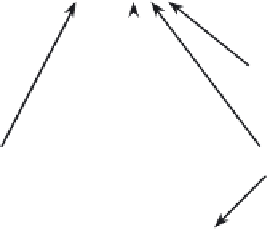Environmental Engineering Reference
In-Depth Information
the ecosystem as a black box and account for only materials entering and
leaving the system.
The nutrient flux diagram is exemplified by the description of a single
nutrient budget that was undertaken to describe the importance of nitro-
gen fixation by a dominant cyanobacterium
(Nostoc)
in a cold-water pond
(Fig. 22.3). Nitrogen fixation was responsible for only about 5% of the ni-
trogen input to the pond. However, this nitrogen input was directly into
biota in the pond, whereas much of the nitrogen input that entered in the
spring inflow rapidly flowed out of the system.
The method of accounting for influx (inputs) and outflux (outputs) of
nutrients is demonstrated with a general analysis of nutrient budgets to as-
sess the importance of various sources and losses of nitrogen across ecosys-
tem types (Table 22.1). Such budgets are central to understanding effects
of nitrogen contamination and related ecosystem processes. For example,
budgets are necessary to determine the ability to use wetlands to remove
nutrient pollution from wastewaters. The data in Table 22.1 suggest that
some wetland types are more retentive of nitrogen than others and that
burial or assimilation in biomass is a significant component of many ni-
trogen budgets. Small habitats have substantial input of nitrogen from lit-
ter, but larger habitats are dominated by water inflows or dry and wet de-
positions. In some systems, nitrogen fixation (generally by cyanobacteria)
can be a major nitrogen input, and denitrification can be a notable loss. A
more in-depth analysis of such budgets for streams and lakes for a variety
of elements is synopsized in Wetzel (2001).
A central issue related to ecosystems has been efforts to establish a re-
lationship between
biodiversity and ecosystem function
(Schulze and
Precipitation+
dry atmospheric
Litter infall
Emergence
Beaver excretion
Log infal
l
15
362
0.1
1397
2383
4436
4126
Dissolved and Particulate N
Dissolved
outflow
Dissolved
inflow
28
1604
Particulate
outflow
Nostoc
528
1.2
484
306
0.4
Caddis larvae
Atmospheric
N
2
37
Atmospheric
N
2
Snails
Logs
6
0.1
10
89
Sediment
Inside pool
4046
Outside pool
Burial
FIGURE 22.3
Diagram of nitrogen fluxes in a cold-water spring (Mare's Egg Spring) dom-
inated by
Nostoc,
a nitrogen-fixing cyanobacterium. Fluxes are given in moles N year
1
(re-
drawn from Dodds and Castenholz, 1988).
























Search WWH ::

Custom Search